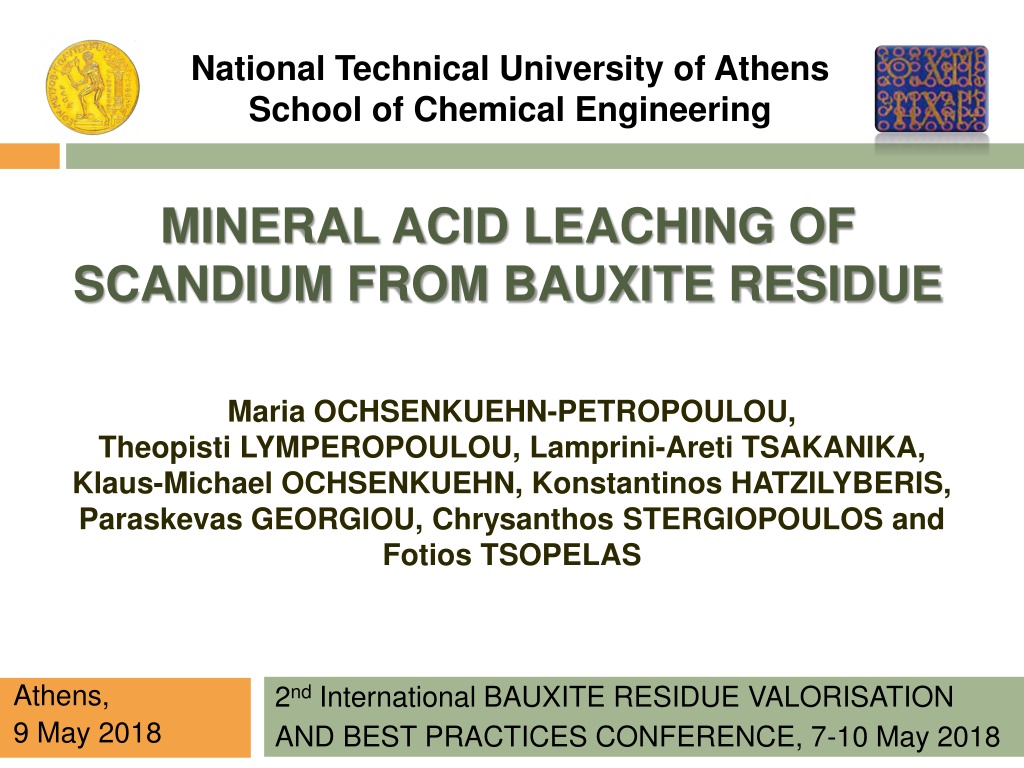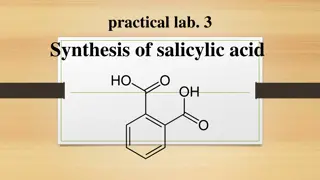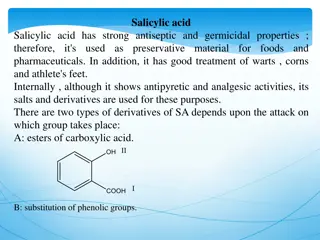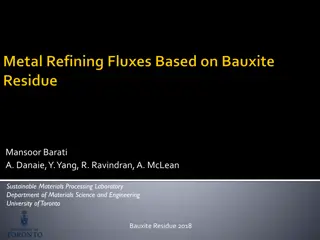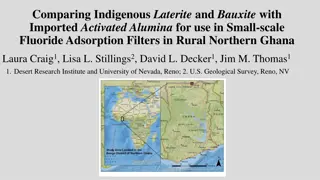Mineral Acid Leaching of Scandium from Bauxite Residue
Bauxite residue, a by-product of alumina production, holds potential for scandium extraction. This study explores the leaching process and economic feasibility of recovering scandium and rare earth elements from Greek red mud. The concentration of scandium and other elements over various batches, potential applications of scandium, recovery methods, and the economics of scandium production are discussed.
Download Presentation

Please find below an Image/Link to download the presentation.
The content on the website is provided AS IS for your information and personal use only. It may not be sold, licensed, or shared on other websites without obtaining consent from the author. Download presentation by click this link. If you encounter any issues during the download, it is possible that the publisher has removed the file from their server.
E N D
Presentation Transcript
National Technical University of Athens School of Chemical Engineering MINERAL ACID LEACHING OF SCANDIUM FROM BAUXITE RESIDUE Maria OCHSENKUEHN-PETROPOULOU, Theopisti LYMPEROPOULOU, Lamprini-Areti TSAKANIKA, Klaus-Michael OCHSENKUEHN, Konstantinos HATZILYBERIS, Paraskevas GEORGIOU, Chrysanthos STERGIOPOULOS and Fotios TSOPELAS Athens, 9 May 2018 2nd International BAUXITE RESIDUE VALORISATION AND BEST PRACTICES CONFERENCE, 7-10 May 2018
Bauxite Residue Bauxite Residue or Red mud: A by-product of alumina production after Bayer process (~40-50 % Fe2O3) Global production: 150 Mt/yr Accumulated amount: 3 billion t Annual production in Greece : 750.000 tons (AoG) Characteristics: Highly alkaline (pH>11) Very fine grained Rich in elements of techno-economical interest (V, Zr, Nb, REEs) Enriched in REEs by a factor of 2 respectively to the original bauxite Scandium comprises 98% of the total value of REEs in Greek BR Full exploitation of BR in AoG can produce about 1 kt/yr of REE oxides
Concentration [g/t] of Sc and REEs in Greek red mud batches (1993-2016) BR 1993 BR 2001 BR 2007 BR 2012 BR 2014 BR 2016 Mean 114.6 12.4 127.9 107.0 130.0 110.0 114.7 98.0 Sc Total REEs 926.9 128.2 986.1 868.0 1010.5 1040.3 729.7 - Results obtained by the Lab of Inorganic & Analytical Chemistry, School of Chemical Engineering NTUA Sc main uses(critical metal for future) Al-Sc alloys (high tech products [0.5-0.8%Sc] for aerospace, defense technology, automobiles, athletic equipment) SOFCs (as electrolyte, improving oxygen-ion conductivity)
Ga, Nb, Zr, REEs and radioactive elements Th, U in BR (g/t BR 2014) Sc 114.7 6.8 Ga 28.6 3.4 Y 92.3 484.8 7.1 Zr Nb 94.0 14.6 La 87.1 305.7 10.3 Ce Pr 20.4 2.1 Nd 74.8 7.6 Sm 15.5 1.6 AVERAGE STDEV 63.6 27.7 Eu Gd Tb Dy Ho Er Tm Yb Lu Th U AVERAGE 3.3 15.4 2.4 15.4 3.2 9.9 1.6 11.0 1.6 83.8 10.2 STDEV 0.3 1.4 0.2 1.0 0.2 0.7 0.1 0.9 0.1 4.8 0.7
Recovery of REEs from Red mud Lab scale Pilot plan Bayer process Bayer process
% leaching recovery 100 % leaching recovery 80 60 40 Aqua regia 20 HCl 0 HNO3 La Yb H2SO4 Y Sc Fe La 32 35 37 68 Yb 52 70 57 74 Y 77 96 80 68 Sc 52 78 68 83 Fe 4 3 12 16 H2SO4 HNO3 HCl Aqua regia
Economics of Sc production Main cost categories throughout the stages of Sc2O3 production from BR: Cost category Stage Investment Cost (annual basis1) Other Operating Cost2 Reagents Cost Acid Leaching + ++ + Ion Exchange + ++ + Solvent Extraction + +++ ++ Acid leaching 19% 1 total investment cost distributed within a lifetime of 25 years 2 labor, operating, maintenance cost & overheads Sc Production Cost Breakdown per processing stage Ion exchange 22% Solvent extraction 59%
Economics of leaching process Most critical factor in operation: Reagents cost Purchase cost ratio HNO3/H2SO4 at least 2:1 Leaching agent: HNO3 HNO3 cost 350 $/kg Sc2O3 (16-17% of total production unit cost of Sc2O3) Leaching agent: H2SO4 H2SO4 cost 140-150 $/kg Sc2O3 Using H2SO4compresses leaching cost about 2.3 times
Effect of leaching agent on Th, U, Ga, Zr and Nb recovery 70 % recovery in the leachate 60 50 40 30 20 10 0 Th U Ga Zr Nb HNO3 0.6M H2SO4 0.6M
Leaching agents Low High Low Acid Environmental impact Sc recovery Fe recovery Aqua regia HCl HNO3 H2SO4
Optimization of leaching process with sulfuric acid Investigated variables Leaching time Liquid to solid ratio (pulp density) Acid molarity Final pH Temperature Pressure Multi stage leaching (re-leaching with fresh acid) Leachate recycling (reusing of PLS on fresh BR)
Effect of leaching time 70 60 in the leachate % Sc recovery 50 40 30 20 10 0 0 10 20 30 40 50 60 70 Time (min) 1M 2M 3M L/S=1:20 (ambient conditions) Rapid reaction 5-60 min
Effect of L/S ratio 12 100 10 Sc mg/L leachate 80 2M 3M % Sc recovery 8 60 1M 2M 3M 6 3M 2M 3M 3M 2M 40 1M 2M 4 1M 1M 1M 2M 3M 20 2 1M 0 0 0 5 10 15 20 25 30 0 5 10 15 20 25 30 L/S ratio L/S ratio Critical on Sc concentration No significant effect on Sc recovery
Effect of H2SO4 Molarity 10 mg/L Sc in the leachate 8 6 L/S = 5 4 L/S = 10 2 L/S = 20 0 0 1 2 3 4 Molarity (M) Higher molarities (>3M): no significant effect on Sc recovery, but enhance Fe dissolution economical and environmental impact no gel formation even at lower L/S ratios
Effect of final pH 60.0 50.0 % Sc recovery 40.0 30.0 Final pH measured 20.0 10.0 Final pH adjusted 0.0 -0.3 -0.1 0.1 0.3 0.5 0.7 0.9 Final pH of the leachate Optimum pH range < 0 - 0.3 L/S=5,10,20 &1-3M H2SO4, 60 min, ambient conditions
Effect of temperature and pressure 100 100 Sc Fe Autoclave 230oC (hot plate) Autoclave 160oC (hot plate) 80 80 % recovery Ambient conditions % recovery 60 60 40 40 20 20 0 0 0 50 100 Sc Fe Temperature (oC) Normal leaching conditions: L/S=10 (10%), 2M H2SO4, t=60min Extreme conditions: L/S=3.3 (30%), 2M H2SO4, t=420min, T=85oC Sc = 17ppm but Fe>30000 ppm and Ti>3400 ppm
Concentration of main elements Gel Fe Ti Si formation mg/L 1900 2300 >1375 yes 1:5 (20%) 2M (25 C, 1 atm,1h) 1040 1430 1143 after 2-3days 1:10 (10%) 3M (25 C, 1 atm, 1h) 7688 6550 35 no 1:2.5 (40%) 4M (25 C, 1 atm, 24h) 5900 3260 50 no 1:5 (20%) 4M (25 C, 1 atm, 24h) 32500 3400 25 no 1:10 (10%) 4M autoclave, 24h 31840 3370 88 no 1:10 (10%) 4M (85oC, 4h) High pulp density leads to gel formation. The problem is solved by working with higher molarities.
Multi stage effect (re-leaching with fresh acid) 70 % Sc recovery 60 50 40 30 0 1 2 3 Number of stages Leaching time t=60min, Ambient conditions
Leachate recycling (reusing of PLS on fresh BR) 14000 Leachate Concentration 12000 g Sc /L 10000 mg Fe/L 8000 6000 mg Ti/L 4000 2000 0 0 1 2 3 4 No of cycles Leaching conditions: L/S= 7.5 - 10 (13 10 %), 2M H2SO4, pH ~0, t=60min Ambient conditions
Statistical evaluation One way ANOVA (three categorical two dependent variables) One way ANOVA Contribution to Sc % recovery Contribution to Sc concentration Parameter Acid molarity 6.23 % 6.71 % L/S ratio 22.24 % 70.39 % Leaching time 20.23 % 70.05 %
Model for the theoretical prediction based on diffusion theory Symbols L/Sc : the efficiency of the leaching process regarding Sc, in mg of Sc in leachate /mg of Sc in leached sample of BR, : the concentration of Sc in BR, expressed, in mg of Sc/kg of dry BR, (L/S)reactant (L/S)feed : the Liquid to Solids ratio , in L of acid/kg of dry BR, cs : the concentration (w/v) of the saturated solution in contact with the particles, in mg of Sc/L of acid, KL=k /b, : the overall mass transfer coefficient from particles to the Liquid phase, where: k : the diffusion coefficient, in dm2/min b : the effective thickness of the liquid film surrounding the particles, in dm, S(=Atot/Md) : the specific surface area of BR particles participating in the leaching process, where: Atot : the total area of the solid-liquid interface, in dm2, Md : the total mass of dry BR particles, in kg, and : the mixing residence time, in min. (CSc)BR
Molarity: 1 M H2SO4 7-8 6-7 5-6 4-5 3-4 2-3 1-2 0-1 8 7 (CSc)Leachate (ppm) Sc concentration 6 5 Statistical evaluation 4 3 2 55 45 1 35 25 0 t (min) 15 5101520253035404550 L/S (L acid /kg dry BR) Model 5
Development of flow-sheet for selective Sc leaching from BR The conceptual design for a continuous work L=Leaching reactor. P= Unit for Purification of leachate from solids. M= Mixing unit. BR= Bauxite Residue streams with moisture content. Subscripts: i = input (alkaline solids stream), o = output (acidic solids stream). A= Acid streams (sulfuric acid solutions). Subscripts: f= leaching feed, p= product (PLS), n= new (fresh solution), r= recycling PLS, d= dense acid (93-98% w/w). W= Water stream
Conclusions (1/2) Leaching time up to 60min. Fast process. Leaching time statistically significant for Sc recovery. Low acid molarities ( 1M) are environmentally and economically favorable but result to gel formation due to Si compounds, especially for low L/S ratios. Higher molarities ( 2-3M) increase Sc recovery, allow to work with lower L/S (or, higher pulp density) at the expense of selectivity and economical impact. L/S (pulp density) crucially increases Sc concentration. High pulp density though, result to handling difficulty due to gel formation. Final pH values are associated to acid molarity. Adjusting final pH value close to zero enhances Sc recovery.
Conclusions (2/2) Temperature and pressure effect seems insignificant for Sc recovery when using low acid molarity . High temperatures combined with high molarities (>3M) improve Sc recovery , while selectivity is reduced (higher Fe concentrations). Multi stage leaching improves Sc recovery . Iron recovery remains low. PLS recycling with pH adjustment almost triples Sc concentration but affects the selectivity. Combination of high molarity, high pulp density, elevated temperature, prolonged time and recycling lead to high Sc concentration in the PLS up to 30 ppm, but enhance iron concentration due to its almost total dissolution. Most promising scenario for selective leaching under ambient conditions resulted till now in: 1-2M H2SO4,L/S=10, t=60 min, PLS recycling 1.5 times combined with pH adjustment.
Acknowledgments The research leading to these results has been performed within the SCALE Production of Scandium compounds and Scandium Aluminium alloys from European metallurgical received funding from the European Community's Horizon 2020 Program (H2020/2014-2020), under Grant Agreement No. 730105. The company II-VI is also gratefully acknowledged for the fruitful collaboration in a previous joint project. by-products project and
Thank you for your attention !
